 Year 1956. The first Chapel at McMurdo Station was built in 1956 by pious U.S. Navy Seabees. On May 6,1956, the Chapel was consecrated to Our Lady of the Snows and the bell consecrated to Saint Dismas, the good thief.(see Our Lady of the Snow … Old memories by Patrick McCormick, a proud Antarctic veteran – W.A.P. (waponline.it).
Year 1956. The first Chapel at McMurdo Station was built in 1956 by pious U.S. Navy Seabees. On May 6,1956, the Chapel was consecrated to Our Lady of the Snows and the bell consecrated to Saint Dismas, the good thief.(see Our Lady of the Snow … Old memories by Patrick McCormick, a proud Antarctic veteran – W.A.P. (waponline.it).
At the beginning, it was also known as Chapel of St. Dismas (see the life od St. Dismas at the bottom of this page) after the good thief. Originally there were neither plans nor materials requisitioned to build a chapel, so, they “found” extra materials and built it on their own time. Father Ron O’Gorman of the Christchurch Diocese traveled on an icebreaker and was the first New Zealand priest to celebrate Mass in Antarctica, Dec. 25, 1957.
In preparation for Antarctic research to be conducted during the International Geophysical Year (1957-1958), U.S. Naval Construction Battalion personnel (Seabees) began building McMurdo Station during the 1955-1956 austral summer. The original plans for the station did not include a chapel; instead, religious services were to be held in the station mess hall.
 However, according Admiral George Dufek, who commanded Deep Freeze I, “As the construction of the buildings at McMurdo progressed a mysterious pile of lumber, planks, nails, Quonset hut sections, and assorted materials began to accumulate on a knoll overlooking the camp.” Just few years later the Chapel was renamend as Chapel of the Snow (aka Blue Chapel . Picture aside show how the Chapel was in 1963 and Blue Chapel 1968.
However, according Admiral George Dufek, who commanded Deep Freeze I, “As the construction of the buildings at McMurdo progressed a mysterious pile of lumber, planks, nails, Quonset hut sections, and assorted materials began to accumulate on a knoll overlooking the camp.” Just few years later the Chapel was renamend as Chapel of the Snow (aka Blue Chapel . Picture aside show how the Chapel was in 1963 and Blue Chapel 1968.
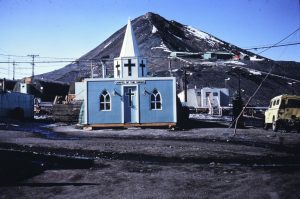 The Chaplain, Father John C. Condit, and volunteers from the construction battalion gradually gathered enough materials to build what was to become the first church ever erected in Antarctica. All of the work was done by volunteers after their daily duties were finished. Admiral Dufek also observed that “The men, after a hard day’s work, would drift over to the church site. Before the main camp was finished a tidy neat church with a steeple was to stand on a ridge overlooking the camp. Later it even had a bell, procured from a small gasoline tanker.” When the Chapel was completed, Father Condit had the world’s most southern parish.
The Chaplain, Father John C. Condit, and volunteers from the construction battalion gradually gathered enough materials to build what was to become the first church ever erected in Antarctica. All of the work was done by volunteers after their daily duties were finished. Admiral Dufek also observed that “The men, after a hard day’s work, would drift over to the church site. Before the main camp was finished a tidy neat church with a steeple was to stand on a ridge overlooking the camp. Later it even had a bell, procured from a small gasoline tanker.” When the Chapel was completed, Father Condit had the world’s most southern parish.
The Chapel of the Snows at McMurdo Station was destroyed by fire on 22 August 1978. No one was injured, but the chapel and almost all its contents were a total loss. For 22 years this simple building provided a place of worship for personnel not only at McMurdo Station (WAP USA-22) but also from nearby Scott Base (WAP NZL-Ø1).
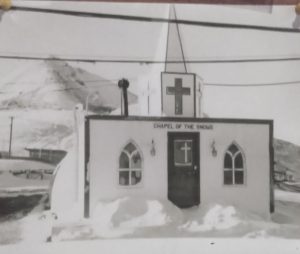 Year 1979. On Easter Sunday 1979, the second Chapel or the Temporary Chapel was dedicated.
Year 1979. On Easter Sunday 1979, the second Chapel or the Temporary Chapel was dedicated.
Here some details: A refurbishing of McMurdo Station was planned by the National Science Foundation, and a new chapel was included in the design. To replace the burned Chapel, volunteers converted a quonset Hut near the station’s main building. While they worked to complete this temporary Chapel, the Chalet served as the site for the community’s religious services. However, this building, which normally houses NSF and contractor offices, could not accommodate both Sunday morning services and daily administrative activities during the summer season.
The Temporary chapel built by the community was left abandoned until it too, suffered a fiery demise during a condition 1 storm on 18 May 1991. It caught fire and was totally destroyed.
 Year 1989. The third chapel was designed to replace the previous temporary one in use as such after the 1978 fire until. The new building was dedicated in 1989.
Year 1989. The third chapel was designed to replace the previous temporary one in use as such after the 1978 fire until. The new building was dedicated in 1989.
Although the original chapel and the temporary building were built entirely by volunteers, the new building was constructed as part of the National Science Foundation’s plan to refurbish the McMurdo Station. The 2,016-square-foot wood structure contains office space, a central worship area that normally seats 63, and McMurdo’s only organ. Materials to complete the building were salvaged from older structures that were ripped down during the several-year rebuilding of the station.
 McMurdo Station once again has a permanent place of worship. To commemorate this occasion, approximately 80 people gathered on Sunday, 29 January 1989 to dedicate the new Chapel of the Snows, which is the third chapel to be raised at the station.
McMurdo Station once again has a permanent place of worship. To commemorate this occasion, approximately 80 people gathered on Sunday, 29 January 1989 to dedicate the new Chapel of the Snows, which is the third chapel to be raised at the station.
The current Capel, the Chapel of the Snows, is the third in the history of McMurdo. It is the southernmost house of worship in the world.
See also: Churches in Antarctica (oceanwide-expeditions.com)
The Life of Saint Dismas
We don’t know much about the life of Dismas. Most of it is the subject of legend. A popular medieval legend surrounding Dismas’ life is:
While the Holy Family was fleeing to Egypt, they stopped to spend the night in a cave. Living in the cave was a family with a son about the same age as Jesus. Sadly, the infant had leprosy, which was a painful and contagious disease. Mary told the mother of the child to bathe him in the water she had just used to wash our Savior. The mother did as Mary instructed and instantly cured the child. The two boys grew up and learned the trade of their fathers. Jesus preached and went about His ministry. While the other became a thief, like his father. The two men met again on Calvary. One of the thieves, traditionally called Gestas, mocked Jesus claiming if He really was the Son of God he could save Himself and them as well.
But Dismas rebuked him saying that they were thieves and received their punishment justly but Jesus was falsely accused. Then turning to Jesus he apologized and asked, ” Lord, please remember me when you go into your kingdom.” Jesus replied, “Today you will be with Me in Paradise.”
Dismas died around 33 in the year of Our Lord.
Saint Dismas’ Feast Day is March 25 and he is the patron of prisoners (especially condemned) and repentant thieves.
 The Captain Pieter J. Lenie Base (WAP USA-12) is an Antarctic summer base operated by the United States located at Copacabana Beach, Admiralty Bay (King George Island). About two kilometers northwest of this base, is the Polish Research Station Arctowski (WAP POL-Ø1).
The Captain Pieter J. Lenie Base (WAP USA-12) is an Antarctic summer base operated by the United States located at Copacabana Beach, Admiralty Bay (King George Island). About two kilometers northwest of this base, is the Polish Research Station Arctowski (WAP POL-Ø1).
 The new building of the Henryk Arctowski Polish Antarctic Station, will become operational in 2023. Two years earlier, as part of the tests, the structure will be assembled in Poland
The new building of the Henryk Arctowski Polish Antarctic Station, will become operational in 2023. Two years earlier, as part of the tests, the structure will be assembled in Poland
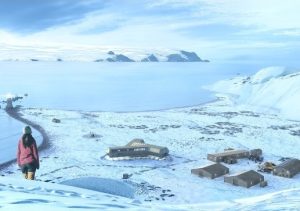 Ministry of Science announced that it would provide a designated purpose to modernize the station`s infrastructure and build a new main building. Its layout will resemble a three-pointed star. In the heart of the station there will be a common space where residents will spend time.
Ministry of Science announced that it would provide a designated purpose to modernize the station`s infrastructure and build a new main building. Its layout will resemble a three-pointed star. In the heart of the station there will be a common space where residents will spend time. The Islas Malvinas Refuge, originally Antonio Moro, is an Antarctic Refuge located at 200 m a.s.l. at 63°25′ South, 56°58′ West, at Nunatak Nobby, Tabarin Peninsula, Bahía Esperanza .
The Islas Malvinas Refuge, originally Antonio Moro, is an Antarctic Refuge located at 200 m a.s.l. at 63°25′ South, 56°58′ West, at Nunatak Nobby, Tabarin Peninsula, Bahía Esperanza . Refugio Islas Malvinas (WAP ARG-New) is one of the 18 shelters that are under the responsibility of the Esperanza base, which is responsible for maintenance and care. It is administered by the Argentine Army.
Refugio Islas Malvinas (WAP ARG-New) is one of the 18 shelters that are under the responsibility of the Esperanza base, which is responsible for maintenance and care. It is administered by the Argentine Army. While waiting two years and three months to be rescued when their sloop Favorite was shipwrecked at Kerguelen in 1825, the British sealer and cartographer John Nunn and his crew spent some miserable months trying to survive on Saddle Island (now called Ile de l’Ouest) at 49°17’59” South, 70°31’56” East, buffeted by the merciless westerly winds.
While waiting two years and three months to be rescued when their sloop Favorite was shipwrecked at Kerguelen in 1825, the British sealer and cartographer John Nunn and his crew spent some miserable months trying to survive on Saddle Island (now called Ile de l’Ouest) at 49°17’59” South, 70°31’56” East, buffeted by the merciless westerly winds.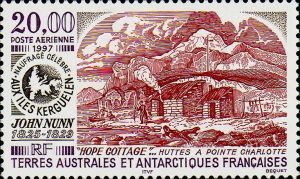 The group was finally spotted in 1827 by Captain Alexander Distant on the schooner Sprightly, belonging to the celebrated shipowner Enderby of London. Nunn and his crewmates joined the Sprightly in hunting whales and elephant seals until 25 March 1829, at which point they were finally returned to Harwich, England four years after the shipwreck.
The group was finally spotted in 1827 by Captain Alexander Distant on the schooner Sprightly, belonging to the celebrated shipowner Enderby of London. Nunn and his crewmates joined the Sprightly in hunting whales and elephant seals until 25 March 1829, at which point they were finally returned to Harwich, England four years after the shipwreck. October 29, marks the fifty-fourth anniversary (1969-2023) of the birthday of Marambio Joint Antarctic Base (
October 29, marks the fifty-fourth anniversary (1969-2023) of the birthday of Marambio Joint Antarctic Base (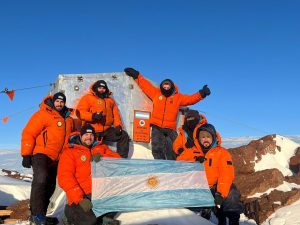 Last mid september 2023, a patrol from the Joint Antarctic Base Belgrano II (
Last mid september 2023, a patrol from the Joint Antarctic Base Belgrano II (
 Antarctica, this remote and mysterious Continent, arouses the curiosity of many people. If you’ve ever considered working there, you’ve probably wondered what the pay is for working in Antarctica. What follows, highlight the different job opportunities on this Continent. To give a more accurate idea of salaries in Antarctica, here are some examples of compensation for different types of jobs:
Antarctica, this remote and mysterious Continent, arouses the curiosity of many people. If you’ve ever considered working there, you’ve probably wondered what the pay is for working in Antarctica. What follows, highlight the different job opportunities on this Continent. To give a more accurate idea of salaries in Antarctica, here are some examples of compensation for different types of jobs: To find job openings in Antarctica, it is recommended to check the websites of the organizations that run research bases on the continent. These organizations include:
To find job openings in Antarctica, it is recommended to check the websites of the organizations that run research bases on the continent. These organizations include: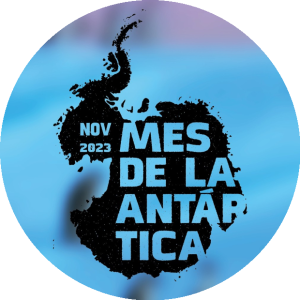 The Chilean Antarctic Institute (
The Chilean Antarctic Institute ( Amateur Radio activities,will be carried out with the purpose of contribute to spreading the presence and operation of the only Antarcticbroadcasting radio station.
Amateur Radio activities,will be carried out with the purpose of contribute to spreading the presence and operation of the only Antarcticbroadcasting radio station. LRA 36, Radio National “Arcángel Sas Gabriel”, is located at 63º 23′ South and 56º 59′ West, in the “Sargento Cabral” blockhouse at Esperanza Base, to the northern end of the Antarctic Peninsula. In front of the bay is the Antarctic Strait, and the Base is at the foot of Mount Flora, an important paleontological site. It is the only shortwave station that Argentina has in Antarctica, and transmits 15,476 KHz. Since this year, transmissions cover 12 months.
LRA 36, Radio National “Arcángel Sas Gabriel”, is located at 63º 23′ South and 56º 59′ West, in the “Sargento Cabral” blockhouse at Esperanza Base, to the northern end of the Antarctic Peninsula. In front of the bay is the Antarctic Strait, and the Base is at the foot of Mount Flora, an important paleontological site. It is the only shortwave station that Argentina has in Antarctica, and transmits 15,476 KHz. Since this year, transmissions cover 12 months. Congrats to Philippe Laurent F6FHO for the Top HR
Congrats to Philippe Laurent F6FHO for the Top HR  Another sad news among the Antarctic chasers and Ham radio community. Prof. Carlo Raso, IK5IWU passed away last week at the age of 82.
Another sad news among the Antarctic chasers and Ham radio community. Prof. Carlo Raso, IK5IWU passed away last week at the age of 82. Keen DXer, Carlo has been the soul and the organizator of several Antarctic Activity Weeks mostly done at the Italian Air Force Bases. We must remember: II2AMI (
Keen DXer, Carlo has been the soul and the organizator of several Antarctic Activity Weeks mostly done at the Italian Air Force Bases. We must remember: II2AMI (

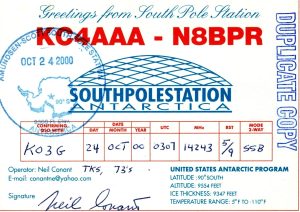 He was chief communications operator and supervisor at KC4AAA – South Pole Station (
He was chief communications operator and supervisor at KC4AAA – South Pole Station ( Duncan Bluff and Communication Heights in the southern part of the Darwin Mountains in Antarctica, was named after Neil, a genuine veteran of the ice ».
Duncan Bluff and Communication Heights in the southern part of the Darwin Mountains in Antarctica, was named after Neil, a genuine veteran of the ice ».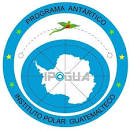 Get to know the first Guatemalan Polar Institute in the city of Huehuetenango that has a museum called
Get to know the first Guatemalan Polar Institute in the city of Huehuetenango that has a museum called 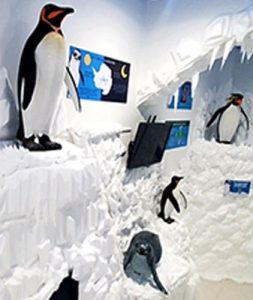
 More than 100 Russian Radio Amateurs are joining a very important event in the city of Orel.
More than 100 Russian Radio Amateurs are joining a very important event in the city of Orel. UA9OBA Yuri Zaruba (
UA9OBA Yuri Zaruba ( Would anyone like to send a postcard from the penguin post office in Antarctica?
Would anyone like to send a postcard from the penguin post office in Antarctica?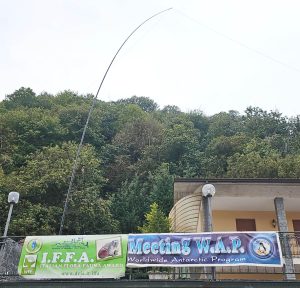 The 20th W.A.P. Meeting “Worldwide Antarctic Program”, together with the 22nd Diploma Castelli d’Italia e della Provincia di Cuneo” and the 14th I.F.F.A. Meeting “Italian Flora Fauna Award” took place on Sunday 17th September in Northen Italy on the hills of the City of Mondovì.
The 20th W.A.P. Meeting “Worldwide Antarctic Program”, together with the 22nd Diploma Castelli d’Italia e della Provincia di Cuneo” and the 14th I.F.F.A. Meeting “Italian Flora Fauna Award” took place on Sunday 17th September in Northen Italy on the hills of the City of Mondovì.
 The Australian expeditioner requiring urgent medical care has been airlifted in a “complex operation” from the Casey Research Station (
The Australian expeditioner requiring urgent medical care has been airlifted in a “complex operation” from the Casey Research Station (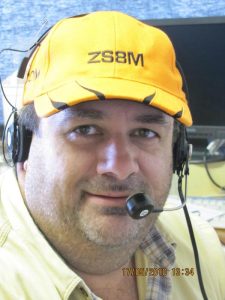 Another sad news!
Another sad news!
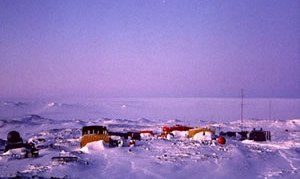 Australia has launched an urgent operation to rescue a researcher with a “developing medical condition” from the remote Casey Research Station (
Australia has launched an urgent operation to rescue a researcher with a “developing medical condition” from the remote Casey Research Station ( Located in the remote South Atlantic Ocean, South Georgia Island has a reputation for the greatest density of wildlife on earth. It’s home to king penguins, fur seals, and 50 percent of the world’s southern elephant seals.
Located in the remote South Atlantic Ocean, South Georgia Island has a reputation for the greatest density of wildlife on earth. It’s home to king penguins, fur seals, and 50 percent of the world’s southern elephant seals.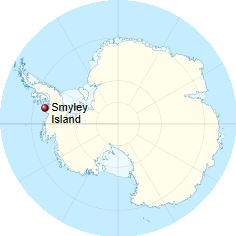 Smyley Island is an Antarctic island lying off the Antarctic Peninsula at coordinates (72°55′South, 78°0′West). The island is 61 km (38 mi) long and from 13 to 34 km (8 to 21 mi) wide and lies about 20 kilometers (12.4 miles) north of Case Island and the island connects to the Stange Ice Shelf. Smyley island is one of the 27 islands of Palmer Land,
Smyley Island is an Antarctic island lying off the Antarctic Peninsula at coordinates (72°55′South, 78°0′West). The island is 61 km (38 mi) long and from 13 to 34 km (8 to 21 mi) wide and lies about 20 kilometers (12.4 miles) north of Case Island and the island connects to the Stange Ice Shelf. Smyley island is one of the 27 islands of Palmer Land,  A catastrophic die-off of emperor penguin chicks has been observed in the Antarctic, with up to 10,000 young birds estimated to have been killed. The event, in late 2022, occurred in the west of the continent in an area fronting on to the Bellingshausen Sea.
A catastrophic die-off of emperor penguin chicks has been observed in the Antarctic, with up to 10,000 young birds estimated to have been killed. The event, in late 2022, occurred in the west of the continent in an area fronting on to the Bellingshausen Sea.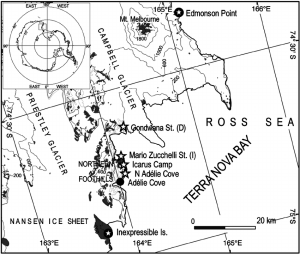 o the Italian MZS Station (
o the Italian MZS Station ( They dug an ice cave and built a rock shelter, though suffered greatly from frostbite, hunger and dysentery. They gave the name “Inexpressible Island” in recognition of how awful the place and time they spent there was.
They dug an ice cave and built a rock shelter, though suffered greatly from frostbite, hunger and dysentery. They gave the name “Inexpressible Island” in recognition of how awful the place and time they spent there was.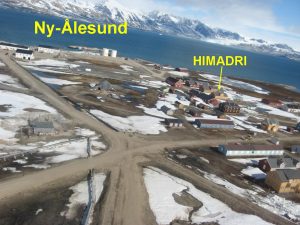 The cost of the vessel is now estimated to be ₹ 2,600 crore, he noted. “I am hopeful that in this financial year, we should be ready to propose this estimate and move in the Cabinet. In the next five years, we should be ready with the ship,” Mr Rijiju stated.
The cost of the vessel is now estimated to be ₹ 2,600 crore, he noted. “I am hopeful that in this financial year, we should be ready to propose this estimate and move in the Cabinet. In the next five years, we should be ready with the ship,” Mr Rijiju stated.
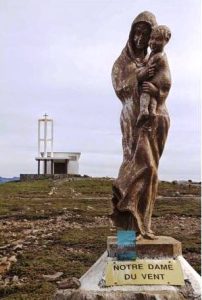 Also known as the Desolation Islands, the Kerguelen archipelago consists of 300 islands, islets, and reefs which lie between 48° to 50° South and 68° to 70° East, covering an area of 7,215 km² (2,786 mi²) .
Also known as the Desolation Islands, the Kerguelen archipelago consists of 300 islands, islets, and reefs which lie between 48° to 50° South and 68° to 70° East, covering an area of 7,215 km² (2,786 mi²) . WAP-WACA
WAP-WACA
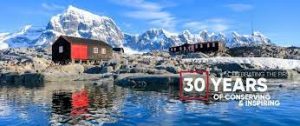 On 28 July,
On 28 July,  “While we’re using the moment to celebrate our successes (and grab a truly unique slice of cake), it is also a time to look forward. Antarctica is complex, fragile and rapidly changing – and so too is its heritage. As such, UKAHT must also keep evolving and rethinking our role to best champion our cherished sites and
“While we’re using the moment to celebrate our successes (and grab a truly unique slice of cake), it is also a time to look forward. Antarctica is complex, fragile and rapidly changing – and so too is its heritage. As such, UKAHT must also keep evolving and rethinking our role to best champion our cherished sites and Our attentive readers and WAP follower know that DL8JDX did join last year with an Expedition Cruise to Antarctica where he retourned after a long absence at the beginning of 2023.
Our attentive readers and WAP follower know that DL8JDX did join last year with an Expedition Cruise to Antarctica where he retourned after a long absence at the beginning of 2023. Interesting is the chart provided by
Interesting is the chart provided by  Radio Technician), passed away at the age of 96.
Radio Technician), passed away at the age of 96. The picture on the left, taken by Andre le roux van der Merwe a medical doctor of the first South African Expedition (SANAE) to Antarctica shows the first South Africa’s Team at SANAE 1, 1960
The picture on the left, taken by Andre le roux van der Merwe a medical doctor of the first South African Expedition (SANAE) to Antarctica shows the first South Africa’s Team at SANAE 1, 1960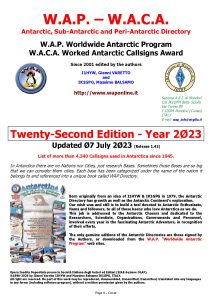
 New
New 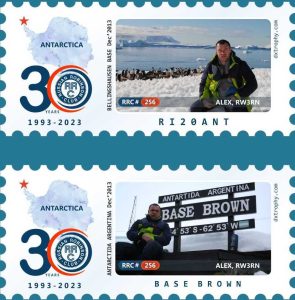 The Club
The Club 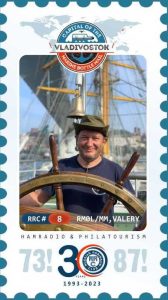 There are several Awards issued for working the various Special stations from July 1st to July 31st 2023.
There are several Awards issued for working the various Special stations from July 1st to July 31st 2023. WAP
WAP
 It’s a real sad news for the whole WW DX Community and in particular to us of
It’s a real sad news for the whole WW DX Community and in particular to us of 
 China has resumed construction of its fifth research facility in Antarctica after a years-long lull.
China has resumed construction of its fifth research facility in Antarctica after a years-long lull.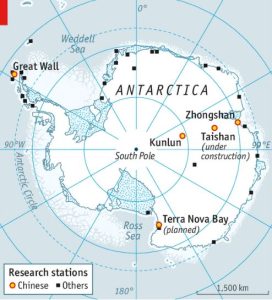
 Victoria Land, is a rocky island where the Northern Party of Robert Falcon Scott’s Terra Nova Expedition of 1910 – 1913 was forced to overwinter in 1912.
Victoria Land, is a rocky island where the Northern Party of Robert Falcon Scott’s Terra Nova Expedition of 1910 – 1913 was forced to overwinter in 1912.  The “Cosmos”, the central hub, is formed of four separate rooms all connected by tunnels that look like the docking station to a spaceship. Inside, the ‘sky pods’ are no less futuristic, with vast floor-to-ceiling windows that bring the ageless landscape of Antarctica inside each lounge, bar or dining space. Even in the comfort and warmth of these living areas, I was connected to the environment. Padded walls encircle a delicate Art Deco bar, while an Anthony James art sculpture glows like a giant power source at one end. Walking through the tunnel I discover a library and daybed with someone napping under a cashmere blanket. The sign on the door read “Decompression Chamber”
The “Cosmos”, the central hub, is formed of four separate rooms all connected by tunnels that look like the docking station to a spaceship. Inside, the ‘sky pods’ are no less futuristic, with vast floor-to-ceiling windows that bring the ageless landscape of Antarctica inside each lounge, bar or dining space. Even in the comfort and warmth of these living areas, I was connected to the environment. Padded walls encircle a delicate Art Deco bar, while an Anthony James art sculpture glows like a giant power source at one end. Walking through the tunnel I discover a library and daybed with someone napping under a cashmere blanket. The sign on the door read “Decompression Chamber”

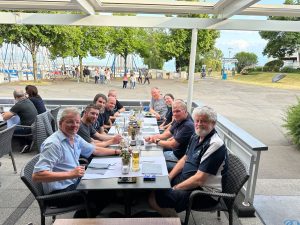 At the Antarctic Dinner Meeting (pic aside) there were: DK5HH, DM2KX, DL3LRM, HB9HCF, HB9BRH, DL8JDX, DC1TH, DJ0HO, DL5XL, DK3ZL. Theresa, DC1TH brought a model of the Neumayer 3 Station to the meeting. She printed all parts of this model with a 3D Printer.
At the Antarctic Dinner Meeting (pic aside) there were: DK5HH, DM2KX, DL3LRM, HB9HCF, HB9BRH, DL8JDX, DC1TH, DJ0HO, DL5XL, DK3ZL. Theresa, DC1TH brought a model of the Neumayer 3 Station to the meeting. She printed all parts of this model with a 3D Printer.
 Meeting with DL7VEE, DL5EBE, DL8JDX (
Meeting with DL7VEE, DL5EBE, DL8JDX (

 ARGENTINA
ARGENTINA NEW ZEALAND
NEW ZEALAND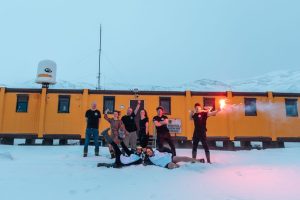 POLAND
POLAND UK
UK
 SOUTH AFRICA
SOUTH AFRICA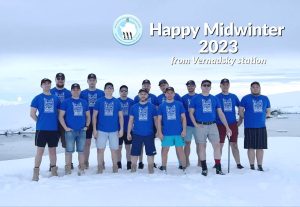 This is the main holiday of polar explorers, which marks the Midwinter, the shortest day and the longest night, but then, gradually, the days become longer, and summer is closer and closer.
This is the main holiday of polar explorers, which marks the Midwinter, the shortest day and the longest night, but then, gradually, the days become longer, and summer is closer and closer. WAP
WAP 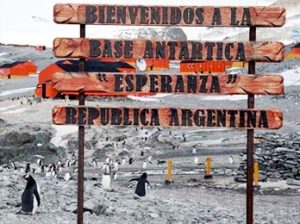 The purpose of the radio beacon is to provide the world’s radio amateur community with a tool
The purpose of the radio beacon is to provide the world’s radio amateur community with a tool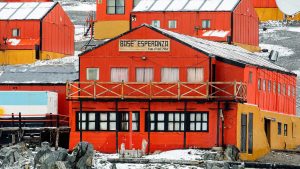 The FT8 signal is emitted at 2500 Hz so as not to affect normal QSO traffic, likewise the CW signal is emitted at the same frequency to be detected manually or automatically by other systems. In FT8 mode it is broadcast both in odd and even sequence to allow its reception regardless of the operational configuration of the radio amateurs at any given time. The broadcast sequence is:
The FT8 signal is emitted at 2500 Hz so as not to affect normal QSO traffic, likewise the CW signal is emitted at the same frequency to be detected manually or automatically by other systems. In FT8 mode it is broadcast both in odd and even sequence to allow its reception regardless of the operational configuration of the radio amateurs at any given time. The broadcast sequence is: Last 2022-2023 Summer Antarctic campaign has seen our friend Oleg Sakharov, ZS1ANF operating again from 2 rare spots in Antarctica; Wolf’s Fang Runway (
Last 2022-2023 Summer Antarctic campaign has seen our friend Oleg Sakharov, ZS1ANF operating again from 2 rare spots in Antarctica; Wolf’s Fang Runway (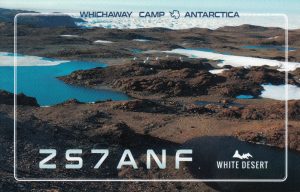 The other rare spot activated on February 2023 by Oleg, has been Wichaway Camp (
The other rare spot activated on February 2023 by Oleg, has been Wichaway Camp ( From June 23 to 25, 2023, HAM RADIO will take place in Friedrichshafen on Lake Bodensee. The trade fair company and the conceptual sponsor, DARC e.V., are currently working on three days of full program for the 46th edition of this successful trade fair. Radio amateurs are experts in communication! Amateur radio is considered an advanced professional qualification for the fields of engineering, computer science, electrical engineering and communications technology. In the labor market, there is a strong demand for students who have degrees in these industries. Radio amateurs live and love technology. The members of the German Amateur Radio Club e.V. pass on this passion to young people in the local associations and set the first impulses for the fascination of technology and the understanding of it..
From June 23 to 25, 2023, HAM RADIO will take place in Friedrichshafen on Lake Bodensee. The trade fair company and the conceptual sponsor, DARC e.V., are currently working on three days of full program for the 46th edition of this successful trade fair. Radio amateurs are experts in communication! Amateur radio is considered an advanced professional qualification for the fields of engineering, computer science, electrical engineering and communications technology. In the labor market, there is a strong demand for students who have degrees in these industries. Radio amateurs live and love technology. The members of the German Amateur Radio Club e.V. pass on this passion to young people in the local associations and set the first impulses for the fascination of technology and the understanding of it..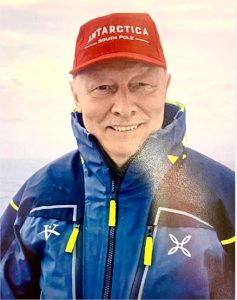 Volker Strecke DL8JDX (ex: Y88POL, DP0GVN) has just informed
Volker Strecke DL8JDX (ex: Y88POL, DP0GVN) has just informed  Oleksandr Gryshko the current Captain of the only Ukraine ice-class research vessel “Noosphere” turns 40 today. His Grandfather and father were senior mechanics, and Oleksandr’s older brother was also a Captain.
Oleksandr Gryshko the current Captain of the only Ukraine ice-class research vessel “Noosphere” turns 40 today. His Grandfather and father were senior mechanics, and Oleksandr’s older brother was also a Captain. When Ukraine purchased the James Clark Ross icebreaker from the UK in 2021 (later it became the Noosphere), it was the first ice-class vessel of Ukraine in the last 20 years. “Noosphere” went on its first Antarctic voyage (2022) under the leadership of experienced British polar Captain Simon Wallace. His experience was taken over by Ukrainian captain Pavlo Panasyuk, who after that began to manage the ship himself.
When Ukraine purchased the James Clark Ross icebreaker from the UK in 2021 (later it became the Noosphere), it was the first ice-class vessel of Ukraine in the last 20 years. “Noosphere” went on its first Antarctic voyage (2022) under the leadership of experienced British polar Captain Simon Wallace. His experience was taken over by Ukrainian captain Pavlo Panasyuk, who after that began to manage the ship himself. nowledge to Oleksandr Gryshko, who at that time, had 20 years of experience working in various seas. The first part of the ship’s journey was from Cape Town to the Polish Antarctic station Arktowsky (
nowledge to Oleksandr Gryshko, who at that time, had 20 years of experience working in various seas. The first part of the ship’s journey was from Cape Town to the Polish Antarctic station Arktowsky (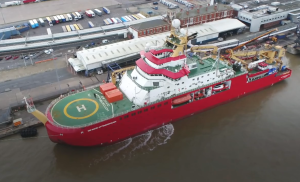 The 129m (423ft) Polar ship is due to leave again on 8 June for refitting work in Rosyth, Scotland, before being used for further trials on the Scottish coast.
The 129m (423ft) Polar ship is due to leave again on 8 June for refitting work in Rosyth, Scotland, before being used for further trials on the Scottish coast.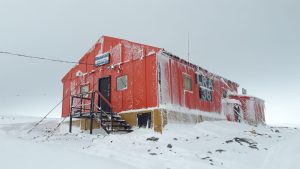 WAP
WAP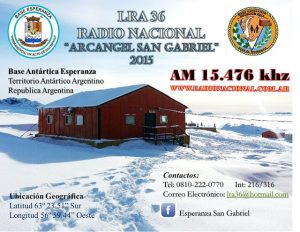 operation from Antarctica in bands and modes with extraordinary results on 6 meters and perhaps the first to operate on FT8, FT4 and FM on 29 MHz in addition to the new 60 meter band. All the hamradio operation are performed from inside the building of LRA36 Radio Nacional Arcangel San Gabriel, using its rombic antenna
operation from Antarctica in bands and modes with extraordinary results on 6 meters and perhaps the first to operate on FT8, FT4 and FM on 29 MHz in addition to the new 60 meter band. All the hamradio operation are performed from inside the building of LRA36 Radio Nacional Arcangel San Gabriel, using its rombic antenna 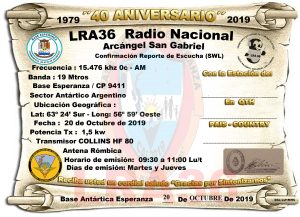 and FT8. The LU1ZV activations have the support of the “Uniendo Voces” a project of the National University of Quilmes (Buenos Aires province).
and FT8. The LU1ZV activations have the support of the “Uniendo Voces” a project of the National University of Quilmes (Buenos Aires province).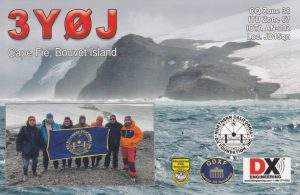 Kapp Fie , 54° 27′ South, 3° 28′ East, at the South East side of Bouvetøya (Bouvet Island), has been issued a reference
Kapp Fie , 54° 27′ South, 3° 28′ East, at the South East side of Bouvetøya (Bouvet Island), has been issued a reference 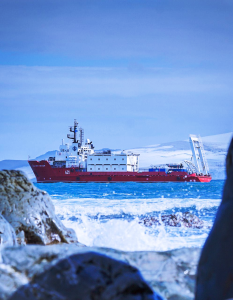 The Bulgarian Polar Research Vessel “Sv. Sv. Kiril i Metodiy (RSV-421)” is owned by a consortium consisting of the Naval Academy, the St Kliment Ohridski University of Sofia and the Bulgarian Antarctic Institute. The Sv. Sv. Kiril i Metodii was ceremoniously christened and commissioned into the Bulgarian Navy inventory on July 27, 2021.
The Bulgarian Polar Research Vessel “Sv. Sv. Kiril i Metodiy (RSV-421)” is owned by a consortium consisting of the Naval Academy, the St Kliment Ohridski University of Sofia and the Bulgarian Antarctic Institute. The Sv. Sv. Kiril i Metodii was ceremoniously christened and commissioned into the Bulgarian Navy inventory on July 27, 2021. Now the Polar ship is docked at Bulgarian port city of Varna (on the Black Sea) after fully completing its participation in the 31st Bulgarian Antarctic Expedition to Livingston Island, Antarctica
Now the Polar ship is docked at Bulgarian port city of Varna (on the Black Sea) after fully completing its participation in the 31st Bulgarian Antarctic Expedition to Livingston Island, Antarctica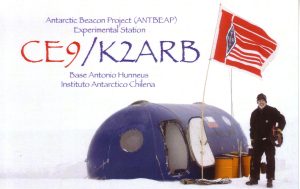 The Base is located at 80°18’ South, 81°20’ West, just 1 km from the Patriot Hills Camp (
The Base is located at 80°18’ South, 81°20’ West, just 1 km from the Patriot Hills Camp ( Prof. Lyubomir Ivanov is the National Representative of Bulgaria to SCAR SCAGI and Chairman of the Antarctic Place-names Commission at Ministry of Foreign Affairs-Republic of Bulgaria. Lyubo is Chairman, Toponymic Board at National Centre for Polar Studies as well.
Prof. Lyubomir Ivanov is the National Representative of Bulgaria to SCAR SCAGI and Chairman of the Antarctic Place-names Commission at Ministry of Foreign Affairs-Republic of Bulgaria. Lyubo is Chairman, Toponymic Board at National Centre for Polar Studies as well. Hard copies of the map could be purchased from
Hard copies of the map could be purchased from  Year 1956
Year 1956 However, according Admiral George Dufek, who commanded Deep Freeze I, “As the construction of the buildings at McMurdo progressed a mysterious pile of lumber, planks, nails, Quonset hut sections, and assorted materials began to accumulate on a knoll overlooking the camp.” Just few years later the Chapel was renamend as Chapel of the Snow (aka Blue Chapel . Picture aside show how the Chapel was in 1963 and Blue Chapel 1968.
However, according Admiral George Dufek, who commanded Deep Freeze I, “As the construction of the buildings at McMurdo progressed a mysterious pile of lumber, planks, nails, Quonset hut sections, and assorted materials began to accumulate on a knoll overlooking the camp.” Just few years later the Chapel was renamend as Chapel of the Snow (aka Blue Chapel . Picture aside show how the Chapel was in 1963 and Blue Chapel 1968. The Chaplain, Father John C. Condit, and volunteers from the construction battalion gradually gathered enough materials to build what was to become the first church ever erected in Antarctica. All of the work was done by volunteers after their daily duties were finished. Admiral Dufek also observed that “The men, after a hard day’s work, would drift over to the church site. Before the main camp was finished a tidy neat church with a steeple was to stand on a ridge overlooking the camp. Later it even had a bell, procured from a small gasoline tanker.” When the Chapel was completed, Father Condit had the world’s most southern parish.
The Chaplain, Father John C. Condit, and volunteers from the construction battalion gradually gathered enough materials to build what was to become the first church ever erected in Antarctica. All of the work was done by volunteers after their daily duties were finished. Admiral Dufek also observed that “The men, after a hard day’s work, would drift over to the church site. Before the main camp was finished a tidy neat church with a steeple was to stand on a ridge overlooking the camp. Later it even had a bell, procured from a small gasoline tanker.” When the Chapel was completed, Father Condit had the world’s most southern parish. Year 1979
Year 1979 Year 1989
Year 1989 McMurdo Station once again has a permanent place of worship. To commemorate this occasion, approximately 80 people gathered on Sunday, 29 January 1989 to dedicate the new Chapel of the Snows, which is the third chapel to be raised at the station.
McMurdo Station once again has a permanent place of worship. To commemorate this occasion, approximately 80 people gathered on Sunday, 29 January 1989 to dedicate the new Chapel of the Snows, which is the third chapel to be raised at the station.
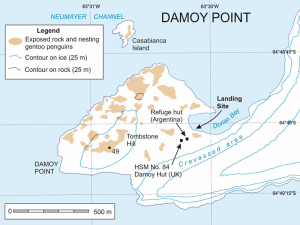 Damoy Point is a headland 900 metres west-northwest of Flag Point, the northern entrance point to the harbour of Port Lockroy, on the western side of Wiencke Island in the Palmer Archipelago of Antarctica. It was discovered and named by the French Antarctic Expedition, 1903–05, under Jean-Baptiste Charcot.
Damoy Point is a headland 900 metres west-northwest of Flag Point, the northern entrance point to the harbour of Port Lockroy, on the western side of Wiencke Island in the Palmer Archipelago of Antarctica. It was discovered and named by the French Antarctic Expedition, 1903–05, under Jean-Baptiste Charcot.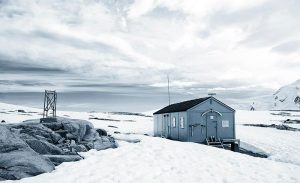 Damoy Hut in 1973 and used for several years as a British summer air facility and transit station for scientific personnel. It was last occupied in 1993, where it served flights to and from a summer-use ice-strip for aircraft used before the sea-ice cleared near Rothera Base. The Damoy Hut (
Damoy Hut in 1973 and used for several years as a British summer air facility and transit station for scientific personnel. It was last occupied in 1993, where it served flights to and from a summer-use ice-strip for aircraft used before the sea-ice cleared near Rothera Base. The Damoy Hut ( In 2023,
In 2023,